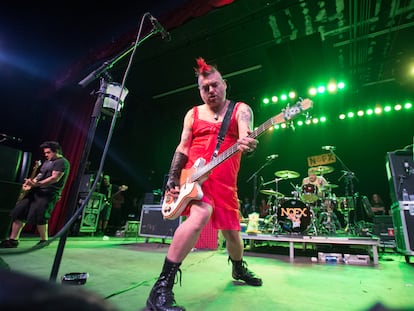Kid Congo Powers, the flaming Chicano who melted the boundaries of rock with The Cramps, Gun Club and Nick Cave
This pioneer of punk, cult guitarist, ex-heroin addict and homosexual activist is presenting a memoir and a new musical project
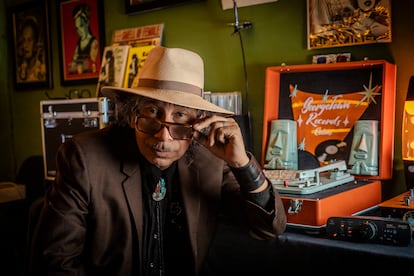

It was Kid Congo Powers’ first gig with The Cramps in Los Angeles. It was a home game for the guitar player, a second-generation Mexican-American raised in the Chicano suburbs of the city of stars. It was also the return of a prodigal son who had just joined a band that condensed punk rock and rockabilly to create its own genre, psychobilly, an amalgam that sounded like garage rock and roll and gore, with a taste for the sinister aesthetics of B movies, leather and leopard prints. A bunch of freaks that represented extreme freedom for a gay, extravagant young man in the conservative United States of the early 1980s.
That night, when it was time to play Sunglasses After Dark, all the members put on sunglasses. There were lit candles on the amplifiers to give the whole affair a ritualistic aura. Kid leaned too close over one of them, but the mix of adrenaline, drugs and darkness prevented him from noticing that his hairspray-covered hair had caught fire. The audience went wild as they continued playing in full frenzy until someone put out the flaming guitarist by pouring a beer on him.
“I didn’t know I was playing with my hair on fire. The funniest thing is that it was perfect for a Cramps concert. At that time I had very long hair, and only the outer part burned. Nothing happened to me, but the smell was terrible. And the audience loved it: they shouted for the rest of the concert. I wouldn’t do it again, though. That was part of the magic: these kinds of things could only happen at a Cramps concert. I’ve never been in another band like that.”
Kid Congo Powers (born Brian Tristan) is a missing link in rock history. His name has remained in the shadows of the industry for the last few decades, unknown to the general public, but treasured as a pioneer among archaeologists of rare and daring sounds. He was responsible for shaping a new genre and melting the boundaries between the aggressiveness of punk and the spirit of traditional American music. In 1980, he founded The Gun Club with Jeffrey Lee Pierce, an undeniable cult band in the first wave of California punk, mixers of the avant-garde with the roots of blues and Americana.
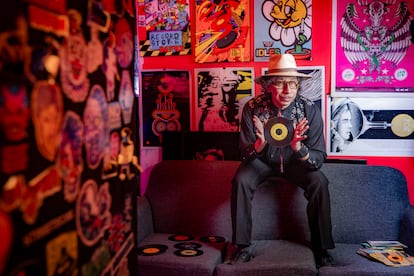
His first performances caught the attention of The Cramps, one of the most unique bands on the scene that was brewing around the legendary New York CBGB with the Ramones, Blondie, Talking Heads and Television among many other primal myths of counterculture rock. They invited him to join and he recorded with them two of the most important albums in the story of these cornerstones of psychobilly. When that period of wild touring and songwriting as an extreme sport — they went so far as to deprive themselves of sleep for days in order to record in an “animalistic” state, operating by “instinct, not intellect” — came to an end, he found himself unemployed in the bustling midtown London of the mid-1980s. He was rescued by Nick Cave, the king of gothic rock, who dragged him to Berlin at a time in which heroin and creativity ran through his veins in equal measure, to take charge of the six strings of his last great success, Nick Cave & the Bad Seeds.
An unexpected murder
It is a cold morning in early December in Mexico City. When the journalist arrives at the La Calicó café, Kid Congo is already leaning at the bar, sipping a hot cup. He wears a brown jacket, a hat, necklaces that hang down to his navel, square glasses and a mustache. Sort of like a mix between a pachuco and a New Orleans bluesman. He is in the city as the highlight of the Monkey Bee festival. While he was there, he took the opportunity to present his autobiography, Ese vicio delicioso (That delicious vice), at Georgetown Records.
The son of a union welder and a mother that was forced by the time to be a housewife — but who had a “free, wild spirit” — he grew up in an English-speaking Mexican home in the Los Angeles suburb of La Puente. Spanish was a secret that came out during family gatherings. “I think my parents wanted their children to assimilate American culture and succeed,” he says. With little interest in school, as a teenager he began to study Jimmy Hendrix’s psychedelia and Frank Zappa’s virtuosity. He was amazed by the glam and the aggressive cross-dressing of the New York Dolls. He discovered a new world with the androgyny of David Bowie and the punk poetry of Patti Smith.
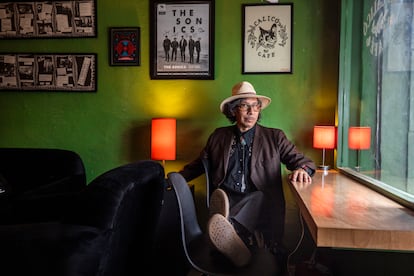
He became a regular at the city’s punk and rock concerts. Among that crowd of extraterrestrial, ragged worshipers of that new religion, he found his people. “I was confused, as young people are, and I was trying to fit in. When I wrote the book I discovered that my cultural identity had been erased by punk rock — in a good way. Especially in the Los Angeles scene, there was a rejection of all labels: race, sexuality, any assimilation of popular culture except music. It was a small tribe of outcasts and misfits who wanted to do and say things differently,” he recalls. He knew drugs and excesses. Years later, Kid would realize that his consumption was an attempt to numb the pain caused by the loss of his cousin Theresa.
“We were like confidants. I told her I was gay, which was a secret at that time. Then she was murdered and the door closed on me. I was disappointed with life. There were no adults to explain anything to me or ask me what I thought. I don’t blame them, they were dealing with their own pain, but I know that is what sparked a change within me.”
“Is this going to end in a riot, or an orgy?”
By the time he was 20, he was already a young veteran on the scene, jaded and addicted to the thrills of hard drugs, alcohol and petty crime. Then the Ramones appeared, a never-before-seen sonic revolution with their three-chord songs, leather jackets and neighborhood thug poses. He became so obsessed with them that he founded their fan club. It was a close atmosphere with no boundaries between the bands and the audience, who got drunk and hung out together. When the Ramones went to Los Angeles on tour, Kid and his pack of punks took them to their favorite record and comic book stores. On another occasion, Debbie Harry, the face of New York cool and the voice of Blondie, got so high smoking weed with them that she ended up falling on a bush.
Looking for a change of air, he headed to New York. “We couldn’t bear the idea of being left out of the CBGB scene. It was like going to Mecca. We wanted to go where the New York Dolls started, see what Richard Hell was like. The important thing about being punk was to keep moving,” he explains. He slept on sofas and apartment floors, he wandered, ate out of a diner’s garbage. He also learned to play the guitar, thanks to Lydia Lunch, an underground icon with her no wave band Teenage Jesus & the Jerks. A full-fledged initiatory journey that would end with a Cramps concert, still without an album, at the CBGB. The first contact. “You immediately realized that something insane was going on. It was a whole new language. At that time the Cramps seemed like they were from outer space. They were sexy, dangerous and fun at the same time; very intoxicating. You wondered, ‘Is this going to end in a riot, or an orgy?’”
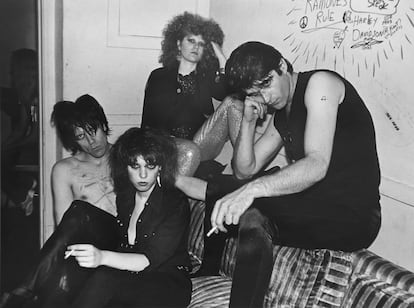
Gun Club was taking its first steps in tiny rooms, with no record to defend. Lux Interior and Poison Ivy, the singer and guitar player of the Cramps, saw Kid, who at that time was still called Brian (it was they who changed his name) and recruited him. His Gun Club colleagues were not angry: anyone would have gone with that couple of unhinged geniuses. “Being in the Cramps was intimidating. I had only been playing the guitar for a year and still couldn’t play that well, but they saw something in me that fit their vision. It was wonderful. Wild. I couldn’t believe what happened on stage. Lux Interior was like a magician, he did incredible things that you wouldn’t have thought anyone could have survived. He was very free.”
The tours began. On the road, excesses were the norm. “It was my first lesson in how to be free. Rock and roll went well with high people, it was tolerated,” he points out. However, the substances that seasoned the nights were not the center of his world:
“Creating was the most important part. Drugs were present in all the bands, but we knew that the most important thing was to do something fantastic, something that said something different. Jeffrey Lee Pierce, The Cramps, Nick Cave, they all had a very strong vision of what they wanted to be, what they wanted to achieve. The common element I saw in all of them was that they had an unbreakable will and were very protective of their magic, they were not willing to compromise it for anything,” he says. As for him, “I wanted to make music that was different from what already existed; it had to be intense and have an impact on people, create emotions. That’s what I was looking for, for it to be exciting.”
“Drugs have that romantic sense of contemplating the abyss... and many people fell”
When his idyll with the Cramps ended due to disputes with the record company, The Gun Club welcomed him back with open arms. It was the most constant band in his career, despite several comings and goings, often marked by the heroin problems of both founders. “Everyone has demons. We thought we were looking for otherness, and drugs make you feel the other, they have that romantic sense of contemplating the abyss... and many people fell. We were looking for people who thought like us. That whole sense of strangeness was our way of feeling outside the rules, of not having to follow anyone. So we lived a bit like wild cats: take what you want, do what you want. The rest is for suckers.”

The following years he got lost in Los Angeles, New York, London and Berlin. In the German capital he witnessed the fall of the Wall from the recording studio where they were putting the finishing touches on a new album by Nick Cave & the Bad Seeds, The Good Son (1990). Dizzying times that came to an end with the death of Jeffrey Lee Pierce in 1996, at the age of 37, after a drug and alcohol bender that destroyed his system. That was the turning point for Kid. “Jeffrey was more than just a musician I worked with. He was my brother. We could argue, but we always made up.”
Looking back, there are few regrets, despite the painful chapters. “Those years were like going to school. They were my college education. I was learning, experimenting, doing what I said I wanted to do when I was 15. There were very dark things and there were also incredible and creative things. I am very proud of everything I have been involved in. I was a teenage music fan, and now I think: how did I do it?” A solo career lies ahead: the poisoned sounds of a veteran with nothing to prove, but still in search of strong emotions.
Sign up for our weekly newsletter to get more English-language news coverage from EL PAÍS USA Edition
Tu suscripción se está usando en otro dispositivo
¿Quieres añadir otro usuario a tu suscripción?
Si continúas leyendo en este dispositivo, no se podrá leer en el otro.
FlechaTu suscripción se está usando en otro dispositivo y solo puedes acceder a EL PAÍS desde un dispositivo a la vez.
Si quieres compartir tu cuenta, cambia tu suscripción a la modalidad Premium, así podrás añadir otro usuario. Cada uno accederá con su propia cuenta de email, lo que os permitirá personalizar vuestra experiencia en EL PAÍS.
¿Tienes una suscripción de empresa? Accede aquí para contratar más cuentas.
En el caso de no saber quién está usando tu cuenta, te recomendamos cambiar tu contraseña aquí.
Si decides continuar compartiendo tu cuenta, este mensaje se mostrará en tu dispositivo y en el de la otra persona que está usando tu cuenta de forma indefinida, afectando a tu experiencia de lectura. Puedes consultar aquí los términos y condiciones de la suscripción digital.
More information
Archived In
Últimas noticias
Maduro counterattacks Trump with rhetoric and announces downing of nine drug trafficking aircraft
‘Ecce Homo’: The miraculous disaster that made a small Spanish town famous
Return to sex testing at the Olympics: IOC edges closer to banning transgender women
Trump escalates conflict with Venezuela with the start of covert operations
Most viewed
- Sinaloa Cartel war is taking its toll on Los Chapitos
- Oona Chaplin: ‘I told James Cameron that I was living in a treehouse and starting a permaculture project with a friend’
- Reinhard Genzel, Nobel laureate in physics: ‘One-minute videos will never give you the truth’
- Why the price of coffee has skyrocketed: from Brazilian plantations to specialty coffee houses
- Silver prices are going crazy: This is what’s fueling the rally
